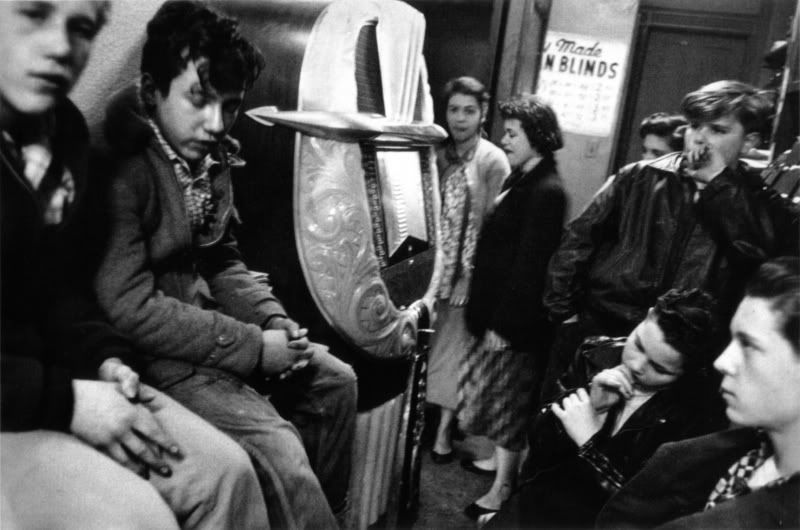the americans by robert frank is pretty amazing.
if you're in to kerouac (daddio)... he happened to write the introduction. i don't personally give a fig about kerouac but the photographs in this book are mind-blowing.
it was published originally in france in 1958 and then in the u.s. in 1959.
the library has an edition from the 1990s for free.
if you want to know about the new edition, you can read about it at powells.

juke box and kids...

3 comments:
"Reality has always been interpreted through the reports given by images; and philosophers since Plato have tried to loosen our dependence on images by evoking a standard of an image-free way of apprehending the real. But when, in the mid-nineteenth century, the standard seemed finally attainable, the retreat of the old religious and political illusions before the advance of humanistic and scientific thinking did not—as anticipated—create mass defections to the real. On the contrary, in the new age of unbelief the allegiance to images was strengthened. The credence that could no longer be given to realities understood in the form of images was now being given to realities understood to be images, illusions."
-susan sontag
I love this book. I first read it in high school and then bought a Robert Frank monograph that Aperture published (along with some other great Aperture monographs by Diane Arbus, Edward Weston & Man Ray). It's funny to think, after reading the Susan Sontag quote Tobi posted, how reliant (and shocked!) people were at that time on photographic representations of Americans. We take for granted now how easy it is to see how other people live. And we also don't privilege sight over sound as much we used to. Look at the Robert Frank book and then browse YouTube. Technological innovation often changes how we perceive others (and ourselves).
I have been reading 'The Ongoing Moment', by Geoff Dyer and since I have the book at hand, I'll copy some paragraphs about 'The Americans' which I think are interesting. It is about the formal aspects of his work that was also shocking (sorry if it's a bit long). By the way, i just realized i have my copy of Robert Frank's book next to 'Banned in D.C.', nice coincidence then!
p167-168
"...Frank's perceived indiference to traditional ideas of visual composition was so challenging at first he could not find an American publisher for the book. It was only after its successful publication in France in 1958 that The Americans came out in the States the following year. The year after that, Ornette Coleman released an album that boldly announced The Shape of Jazz to Come. Though occurring independently of each other these defining moments in music and photography are mutually illuminating.
The history of jazz is the history of listeners growing used to what at first sounds alien, unassimilable. Frank's pictures share with
Coleman's music the need to explore formal boundaries by doing away with them. The objections to the free jazz ushered in by Coleman can easily be carried over to Frank, whose work was judged, by traditional standars, to be unframed, uncomposed. In the late 1950s Coleman's music was revolutionary, unprecedent. Listening to it now we can hear, quite clearly, that it is drenched in the blues that the saxophonist had heard growing up in Fort Worth, Texas. It's the same with Frank. Since his pictures have themselves become part of a tradition we can see how they have come directly out of an earlier phase of that tradition".(...)
p.169
"It was this -the fear of the visual deluge that might come in his wake - as much as what Frank actually did that troubled people. It was wholly appropiate for Kerouac to write the introduction to The Americans, for the questions the Beats prompted a horrified Gore Vidal to ask himself were exactly those posed by Frank. 'Was this what writting was destined to be - an endless report on what one had done the night before while listing the names of the all-alike towns that one sped through on the ever-same road?' Kerouac had already worked out his own answers. Having dissmissed the material of F. Scott Fitzgerald as 'sweetly unnecesary', he went on to inform Neal Cassady that it 'is the exact stuff upon which American Lit is still to be founded'. That was in 1950. Frank's own answer -visual rather than verbal- was that, in some aspects, he was traveling down the ever-same road as [Dorothea] Lange and [Walker] Evans."
Post a Comment